Question 1
Match the description with the best term.
Ions and electrolytes are also these.
Minerals, water, vitamins, and the biological molecules (proteins, lipids, carbohydrates, and nucleic acids) are all together these.
nutrients (all)
The vitamins and biological molecules together are this.
Water and minerals together are this. inorganic nutrients
Question 2
Our large biological molecules come from putting together smaller molecules. One of the four biological molecule categories does not include large molecules, and this smallest type of biological molecule is the [1]. The other three can be HUGE because they are built from true building blocks called [2]. In order to build the larger molecules from smaller ones, [3] reactions must occur. During these building reactions water is [4].
If you use monosaccharides to build larger molecules then you will be making [5]. A specific example of a very big molecule you can make with monosaccharides is [10]. When you put a whole bunch of building blocks together, regardless of which ones, you always make [7] for each of the biological molecule types.
Notice that you can’t use the word “acid” to figure out which molecule goes in which category. For example, fatty acids are used in making [8], while amino acids are used to make [6]. Also, nucleotides are used to make [9].
Question 3
Match each item or description with the appropriate biological molecule group.
Mostly made up of only carbon and hydrogen atoms. lipids
Built from amino acids
Its monomers always have phosphate groups in them and include ATP.
These have no monomers.
The monomers of this group provide us with the chemical energy we need to produce our cellular energy.
Our genetic code fits into this category. nucleic acids
Starch in our diet is a polysaccharide and that fits into this category.
Cholesterol is one example of a molecule in this category.
Question 4
For these questions, match each item with the correct image.
The gray atoms are carbon atoms, the red are oxygen atoms, and the white are hydrogen atoms.
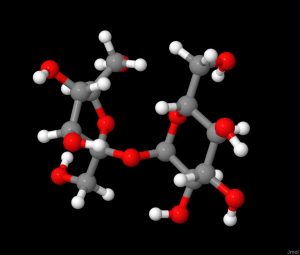
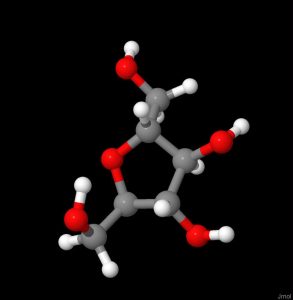
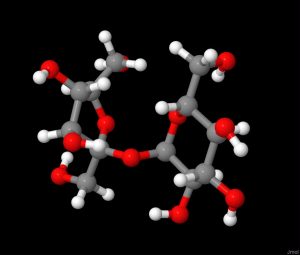
This is glucose
This is fructose
This is a disaccharide.
This is sucrose
Question 5
Here is an image of a biological molecule. It is a ball-and-stick image, where the carbons are gray, the hydrogens are white, and the oxygen is red.
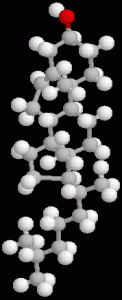
This molecule is a type of lipid. It’s pretty clear that this is a lipid because there are hardly any [1] atoms. Specifically, this molecule is a [2]. You can tell the type of lipid because of the four visible [3].
Based on your understanding of this type of lipid, would it contribute toward building a triglyceride? [4] (yes/no) Would this type of lipid commonly act as a hormone? [5] (yes/no)
Question 6
Match the best answer for each statement.
Amino acids undergo ___ to form polypeptides.
RNA can undergo ___ to release nucleotides.
___ are a type of catabolic reactions. hydrolysis reaction
Nucleotides can come together to make RNA and ___ .
A triglyceride can undergo ___ to release 3 fatty acids and glycerol
Question 7
Here are 4 different images of how the enzyme AChE (acetylcholinesterase) might look based on modeling this large molecule. Based on what you know about enzymes, this molecule is most likely a [1]. This first image is a ball-and-stick image of AChE:
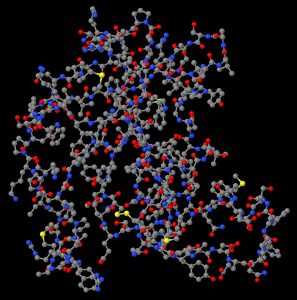
There are a lot of atoms visible in this image. You already know that gray are carbon and red are oxygen. To simplify the model, the hydrogen atoms (usually in white) are not shown. This model also has blue atoms which are nitrogen atoms and yellow atoms which are sulfur atoms. The nitrogen atoms would be found in the [2] group in every amino acid. The sulfur atoms are more rare, indicating that they are found in some of the [3] groups.
AChE has 137 amino acids in it. This image and the number of amino acids might make it seem like a really large molecule, but it is actually on the smaller side. It’s just that with so many atoms it is hard to interpret this image. For example, you know that the amino acids form a chain, but you can’t really see the chain.
So let’s look at another image where you can see the chain. A chain of amino acids is called a [4]. AChE is made up of only one chain, again showing that it is not a really large molecule… just a large molecule and not a small molecule (the amino acid would be the small molecule and this has 137 of them in it).
In this second image, the chain is shown as a line that is colored from one end to the other along a rainbow. The first amino acid is at the dark blue end and the last is at the red end. Because this chain is short enough, you can follow it from blue to red. If you were playing with the model directly you could spin it around which makes this easier.
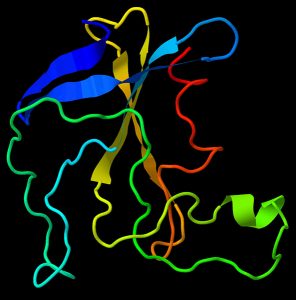
There are 4 levels of structure of this biological molecule. The fact that this molecule has only one chain in it let’s us know that AChE does not have [5] structure. The fact that AChE is built from 137 specific amino acids in a very particular order is part of its [6] structure.
You may have noticed that some areas of this chain are drawn wider than other areas. This makes more sense in the next image, which is the same as this one but colored to reveal the secondary structure of AChE.
In this third image the thicker areas are yellow or pink. Those are the regular secondary structures that can be seen in the chains. You should be able to tell that the pink area is where there is a/an [7] and the yellow areas are where there is a/an [8]. Secondary structure is not all regular, so the white areas reflect irregular structures. Some chains have lots of regular secondary structure and very little irregular secondary structure. But AChE has a lot of irregular secondary structure.
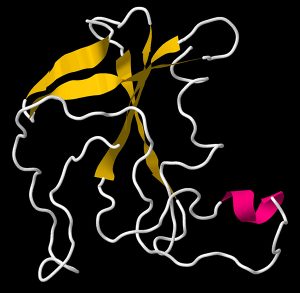
The images that I have shown of AChE so far make it look like there’s a lot of empty space in it. However, that isn’t true. Ball-and-stick models just show where the bulk of any atom takes up space, but not all of the atom. And the chain views just make a line to show the connections from amino acid to amino acid. But these images don’t actually show how much space is taken up by these atoms.
This last view is called a space-fill view. Like the other images, it still shows AChE as sort of an upside-down Y. This shape may let this enzyme grab onto its substrate as if it had two fingers coming down to pinch it from above (the arms of the Y). Just like this molecule has a particular shape, it also is able to undergo conformational changes, or shape changes, in response to what is around it. So if its substrate were below it it could pinch it, which is a shape-change. It will always go back to its original conformation after it is done with its job. You will be learning about conformational changes as you keep going through this course. They are essential for how our bodies work, but you will spend the most time on it in the muscle chapter. It is also in that chapter that you will encounter AChE again.
The overall upside-down-Y-shape of this molecule is its [9] structure.
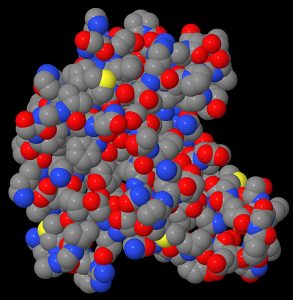
Just to check if you are following all of this, one more question. This one a true/false question. The shape of the molecules in the category that include AChE is always very specific and determined by the amino acids that are in that particular molecule. [10]
Click the purchase button below to purchase all the answers at $15
You May Also Like This:
- (Answered) Human Anatomy and Physiology 1 Homework 3
- (Answered) Human Anatomy and Physiology 1 Homework 20
- (Answered) Human Anatomy and Physiology 1 Homework 19
- (Answered) Human Anatomy and Physiology 1 Homework 24
- (Answered) Human Anatomy and Physiology 1 Homework 1 (5-7)
- (Answered) Human Anatomy and Physiology 1 Homework 1 (1-4)
- (Answered) Human Anatomy and Physiology 1 Homework 5
- (Answered) Human Anatomy and Physiology 1 Homework 7
- (Answered) Human Anatomy and Physiology 1 Homework 6
- (Answered) Human Anatomy and Physiology 1 Homework 28
- (Answered) Human Anatomy and Physiology 1 Homework 17
- (Answered) Human Anatomy and Physiology 1 Homework 25
- (Answered) Human Anatomy and Physiology 1 Homework 15
- (Answered) Human Anatomy and Physiology 1 Homework 18
- (Answered) Human Anatomy and Physiology 1 Homework 16
- (Answered) Human Anatomy and Physiology 1 Homework 8
- (Answered) Human Anatomy and Physiology 1 Homework 11
- (Answered) Human Anatomy and Physiology 1 Homework 10
- (Answered) Human Anatomy and Physiology 1 Homework 21
- (Answered) Human Anatomy and Physiology 1 Homework 2
- (Answered) Human Anatomy and Physiology 1 Homework 32
- (Answered) Human Anatomy and Physiology 1 Homework 27
- (Answered) Human Anatomy and Physiology 1 Homework 13
- (Answered) Human Anatomy and Physiology 1 Homework 9
- (Answered) Human Anatomy and Physiology 1 Homework 12
- (Answered) Human Anatomy and Physiology 1 Homework 31
- (Answered) Human Anatomy and Physiology 1 Homework 26
- (Answered) Human Anatomy and Physiology 1 Homework 23
- (Answered) Human Anatomy and Physiology 1 Homework 22
- (Answered) Human Anatomy and Physiology 1 Homework 30


